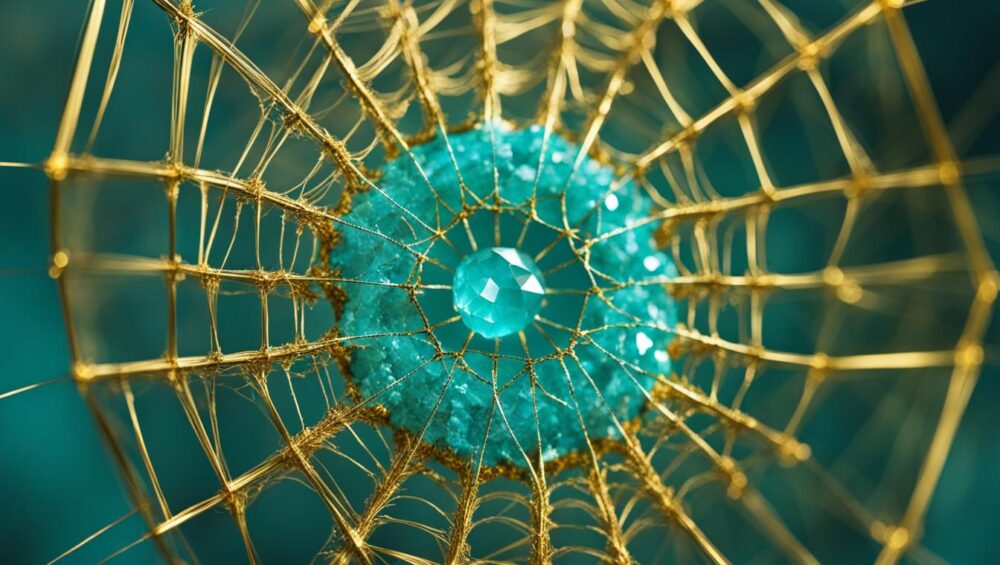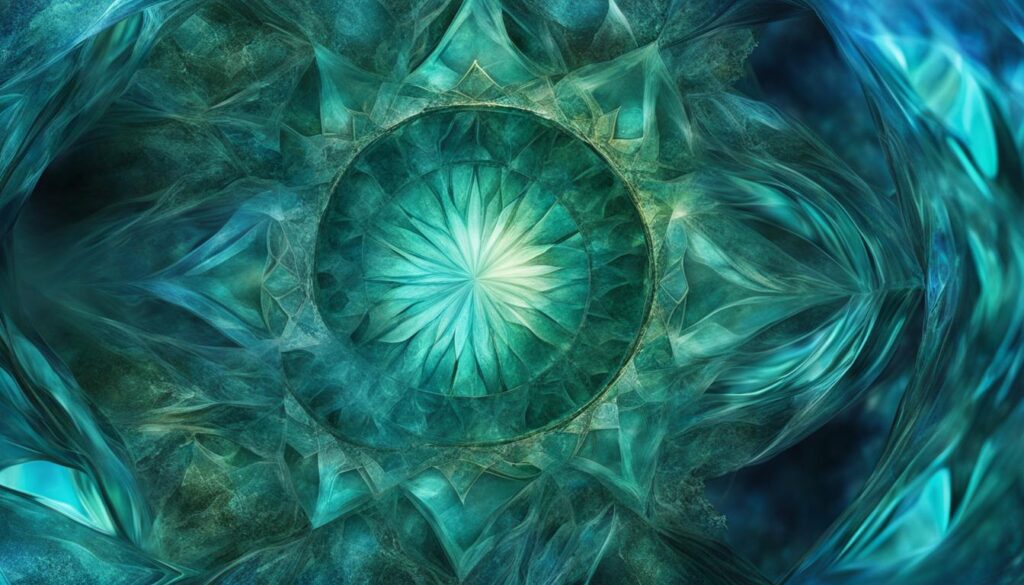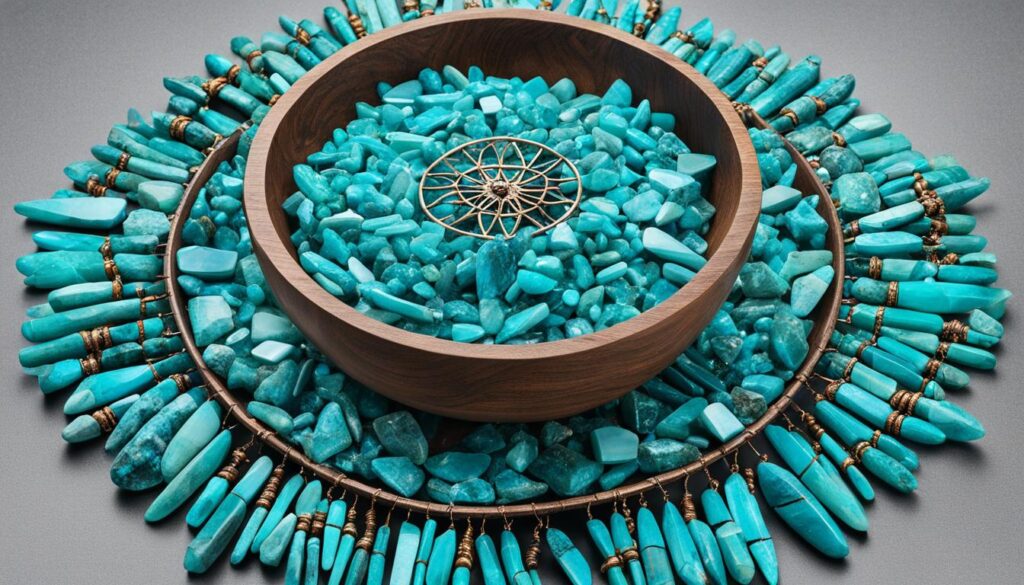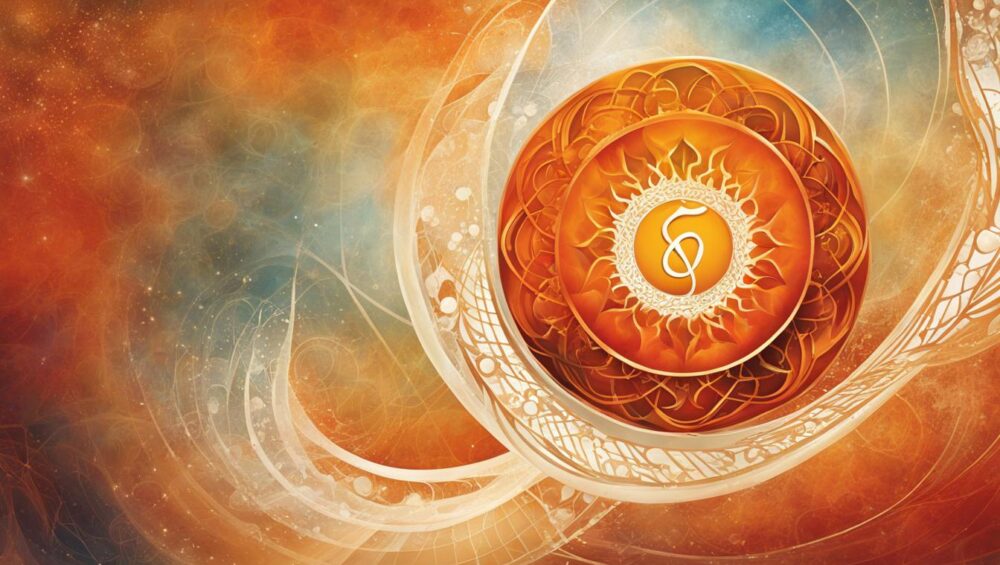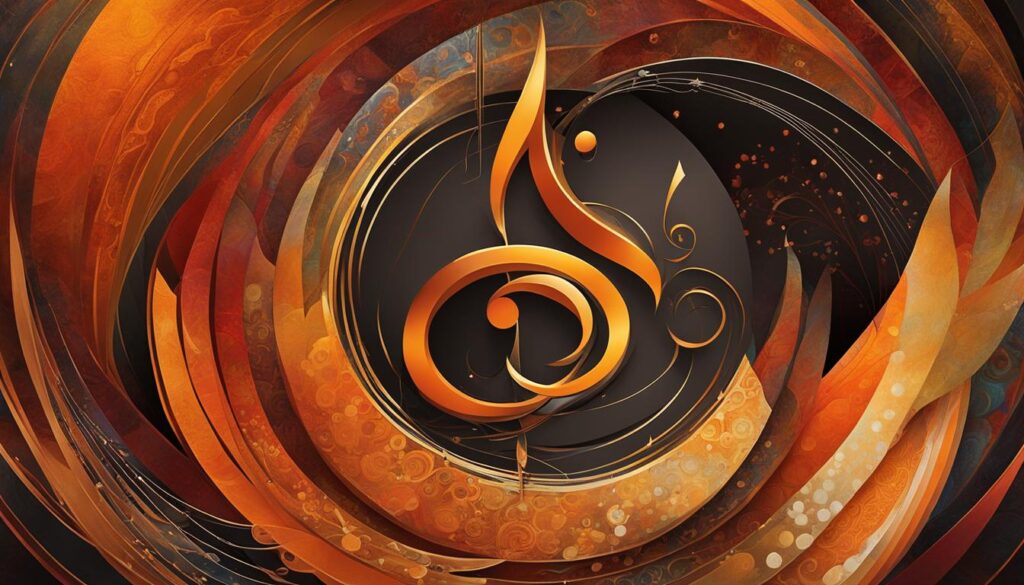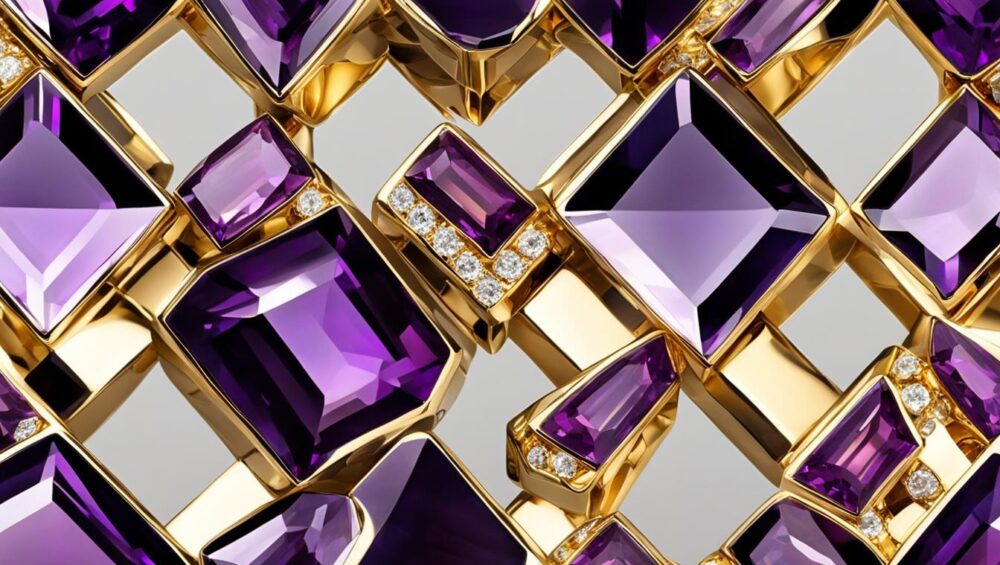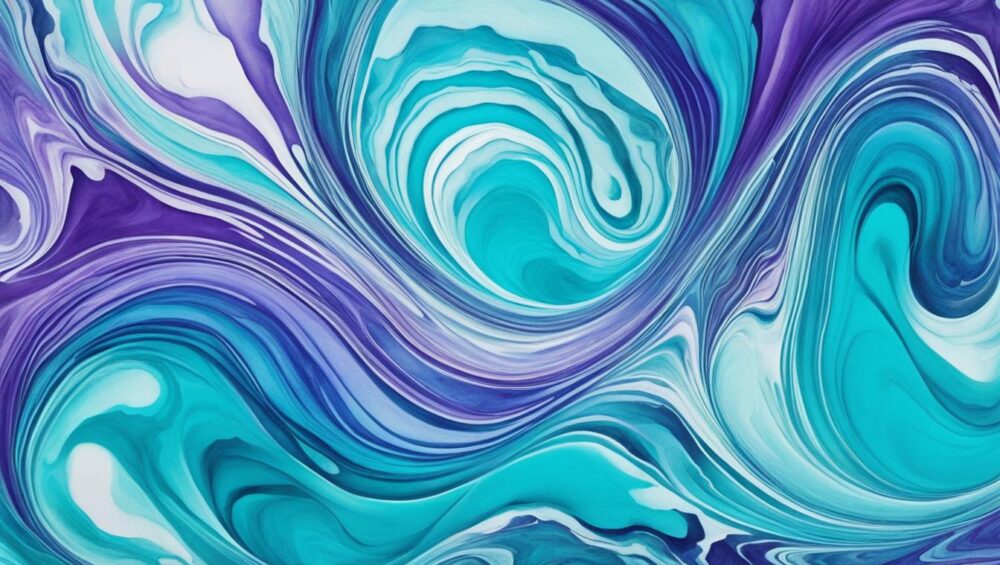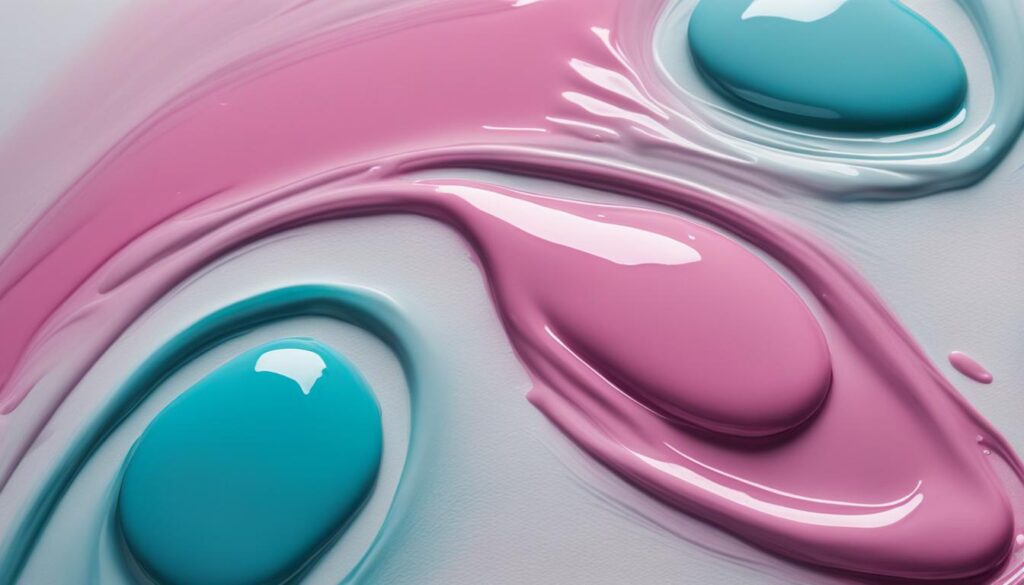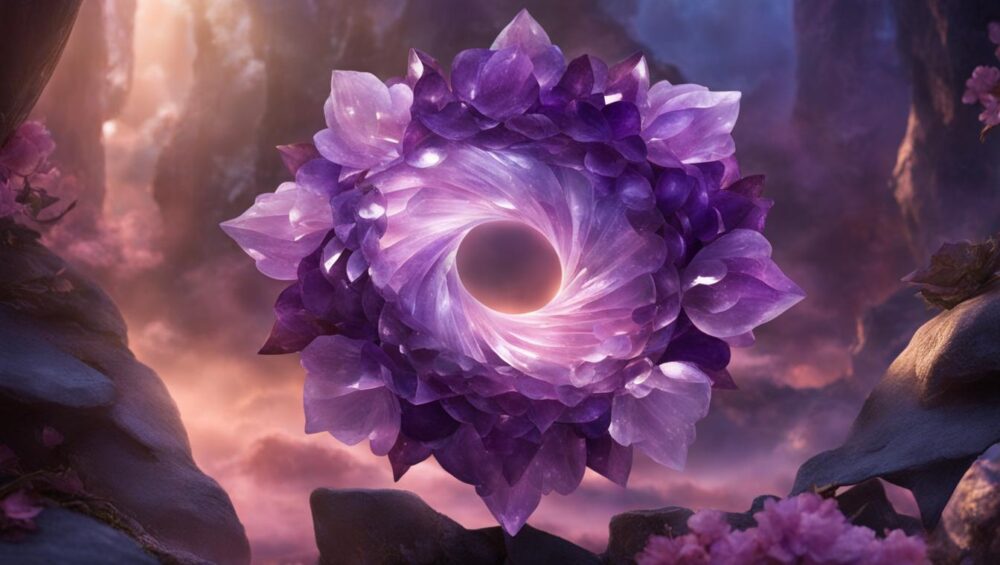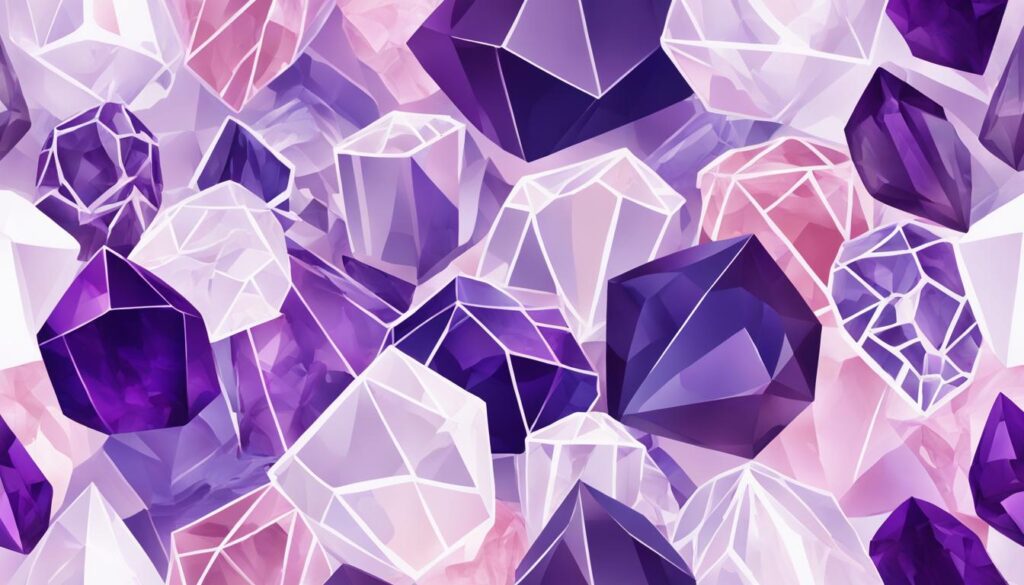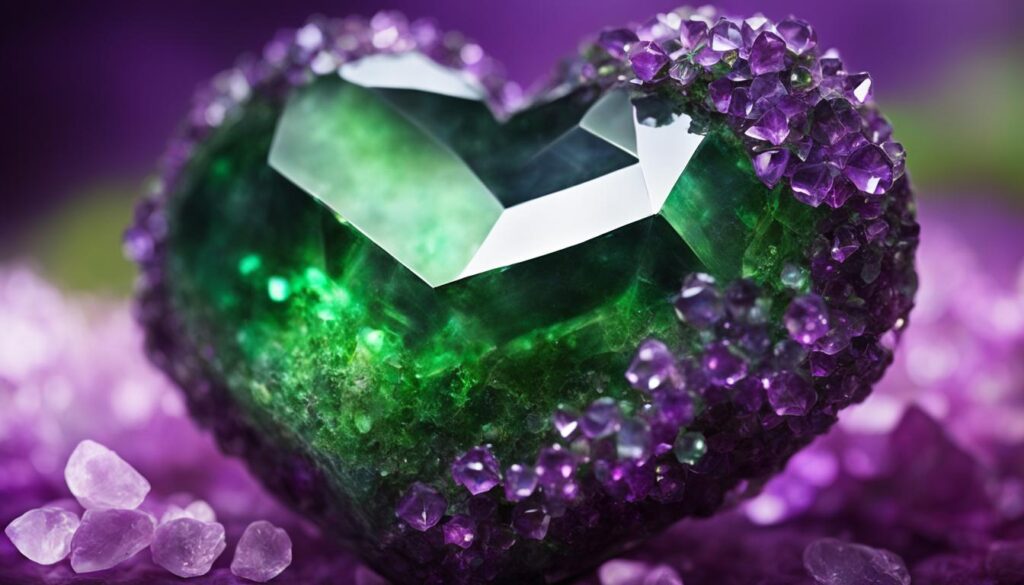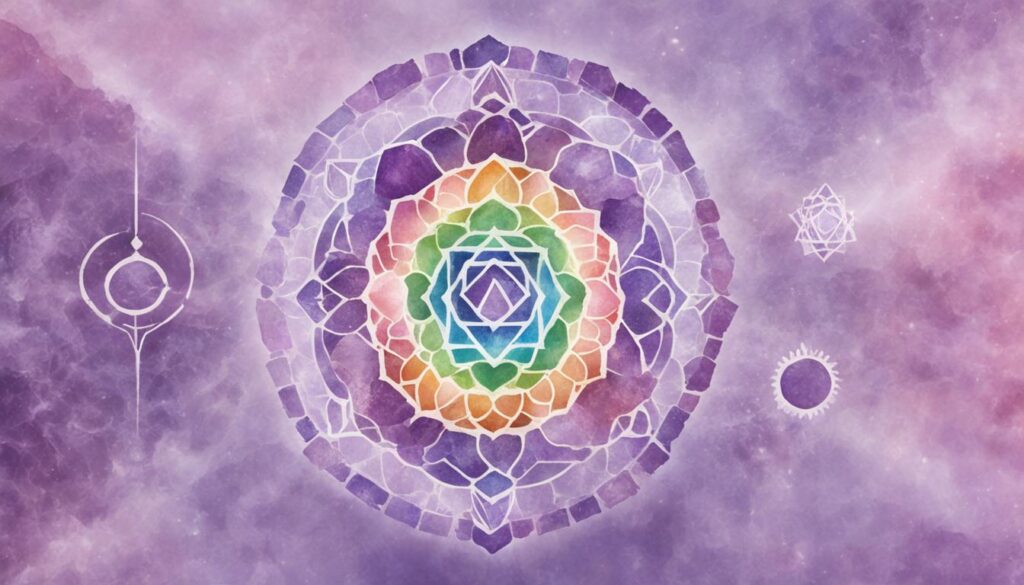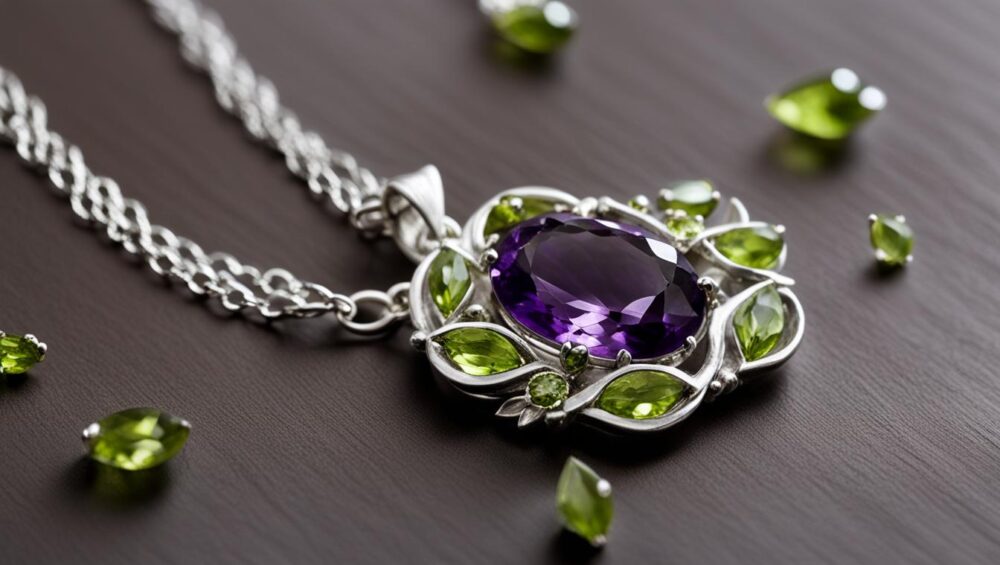Turquoise holds deep spiritual significance in Native American culture and is revered as a sacred stone. It is associated with various beliefs and traditions among different tribes throughout the Southwest states. The stone is highly valued for its unique appearance and local variations in color and pattern. Turquoise is deeply connected to the land and is considered a personal and spiritual stone by native peoples.
Key Takeaways:
- Turquoise is highly valued in Native American culture for its spiritual significance and unique appearance.
- Different Native American tribes have various beliefs and traditions associated with turquoise.
- The stone holds deep connections to the land and is considered personal and spiritual.
- Native American culture values turquoise for its symbolism in communication with spirits and healing.
- Turquoise is a prominent feature in Native American jewelry and art, reflecting the traditions and beliefs of these tribes.
The Importance of Turquoise to the Navajo People
Turquoise holds immense importance in Navajo culture, playing a significant role in their creation myths and spiritual beliefs. According to Navajo legend, the First Man used a chunk of turquoise to create the sun, emphasizing the stone’s sacred nature and connection to the divine.
“Turquoise, the stone of sky and water, is at the heart of our existence. It is a symbol of our origins and a source of healing and protection.” – Navajo Elder
The Navajo people also believe that the great goddess Estsanatlehi appears as a drop of turquoise, further emphasizing the stone’s divine association. Turquoise is deeply intertwined with Navajo rituals and milestones, playing a significant role in every stage of life.
Turquoise Rituals and Milestones
From birth to death, turquoise is present at each significant milestone in Navajo culture. The stone is believed to possess strong healing and protective properties, making it an essential element in Navajo ceremonies and traditions.
- Birth: Newborns are often adorned with turquoise amulets or bracelets to ward off evil spirits and ensure a healthy life.
- Puberty: During puberty ceremonies, young Navajo girls receive turquoise jewelry as a symbol of their transition into womanhood.
- Marriage: Turquoise is a common gift exchanged between couples during Navajo wedding ceremonies, representing love, happiness, and protection.
- Death: In Navajo burial rituals, turquoise is often placed with the deceased to ensure safe passage to the afterlife and provide spiritual protection.
In Navajo culture, cracked turquoise is particularly cherished as it is believed to have absorbed any harm that would have otherwise affected the wearer. The stone is seen as a protector and a guardian, offering comfort and guidance in times of need.
Turquoise Beliefs in Other Native American Tribes
While turquoise has a special place in Navajo culture, it also holds deep spiritual connections for other Native American tribes. Let’s explore the significance of turquoise in the beliefs of the Zuni, Hopi, and Apache tribes.
Zuni Beliefs about Turquoise
The Zuni people have a profound reverence for turquoise, seeing it as a manifestation of the sun’s life-giving power. They associate blue turquoise with the sky, believing it brings protection and blessings from above. Green turquoise, on the other hand, represents the earth’s vitality and is thought to enhance fertility and connection to the natural world.
Hopi and Apache Beliefs about Turquoise
The Hopi tribe has a fascinating legend that explains the origin of turquoise. According to their belief, turquoise is created from the excrement of lizards that travel between worlds. This sacred stone, with its vibrant blue-green hues, is seen as a powerful protector and symbol of good fortune.
The Apache people have a unique association between turquoise and their bows. They believe that by tying turquoise to their bows, they can harness its strength and protective qualities in battle. The stone is considered a source of power that brings courage, focus, and resilience during challenging times.
These diverse beliefs reflect the wide-ranging cultural significance of turquoise among Native American tribes, highlighting its connection to spirituality, protection, and the natural world.
Turquoise as a Symbol of Communication and Healing
Turquoise holds a special place in Native American culture, symbolizing communication with spirits and carrying powerful healing properties. It is believed to bring good fortune and protection, and is incorporated into various ceremonies and rituals to honor its significance.
The Zuni people, for instance, use turquoise in a cup filled with a mixture of turquoise and cornmeal during rituals. This symbolic combination represents their connection to the spirits and their belief in the life-giving power of turquoise. They believe that turquoise acts as a channel for communication with the spiritual realm.
Similarly, the Pueblo tribe ties turquoise to their bows for strength in battle. They associate the stone with rain, which they view as a vital element for nourishment and growth in their arid environment. Turquoise becomes a symbol of protection and well-being.
Furthermore, turquoise is known for its healing properties in Native American culture. It is believed to possess energy that can restore balance and harmony to the mind, body, and spirit. The stone is often used in rituals and ceremonies to promote physical and emotional healing.
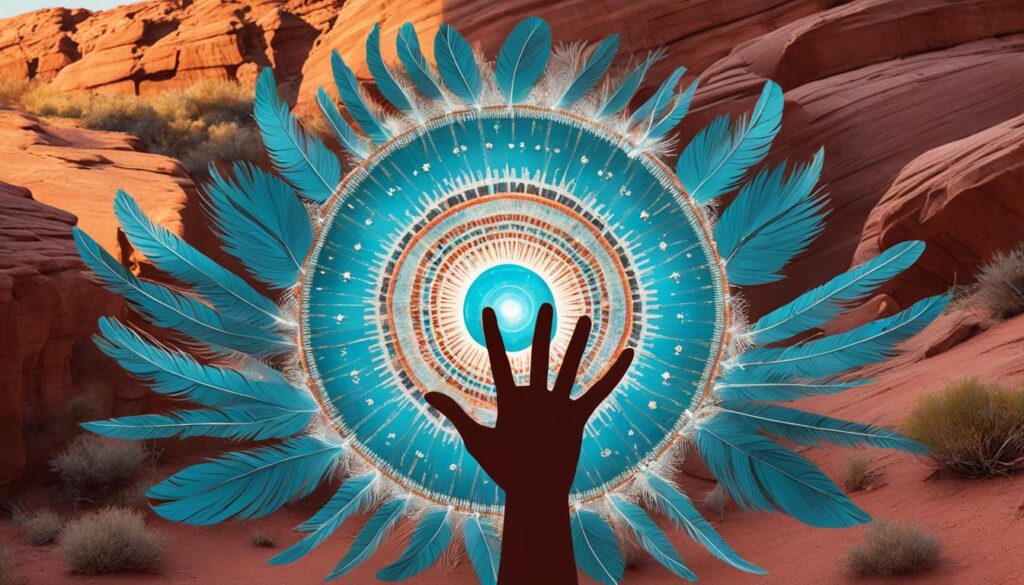
Turquoise in Native American Jewelry and Art
Turquoise is a prominent and cherished gemstone in Native American culture. It holds deep spiritual significance and is widely used in Native American jewelry and art. The Navajo and Zuni tribes, in particular, are renowned for their expertise in turquoise jewelry creation.
The Navajo style of turquoise jewelry is characterized by iconic pieces such as the “Naja” and “Squash blossom” necklaces. These necklaces feature beautiful turquoise stones in intricate settings, showcasing the natural beauty and vibrant colors of the stone. Turquoise is also commonly used in Navajo silver and turquoise jewelry, adding a touch of elegance and symbolism to each piece.
Additionally, the artistry of turquoise inlay rings is a hallmark of both Navajo and Zuni jewelry. These rings feature meticulously handcrafted designs with intricate turquoise inlays, making them unique and highly sought after.
| Navajo Jewelry Style | Zuni Jewelry Style |
|---|---|
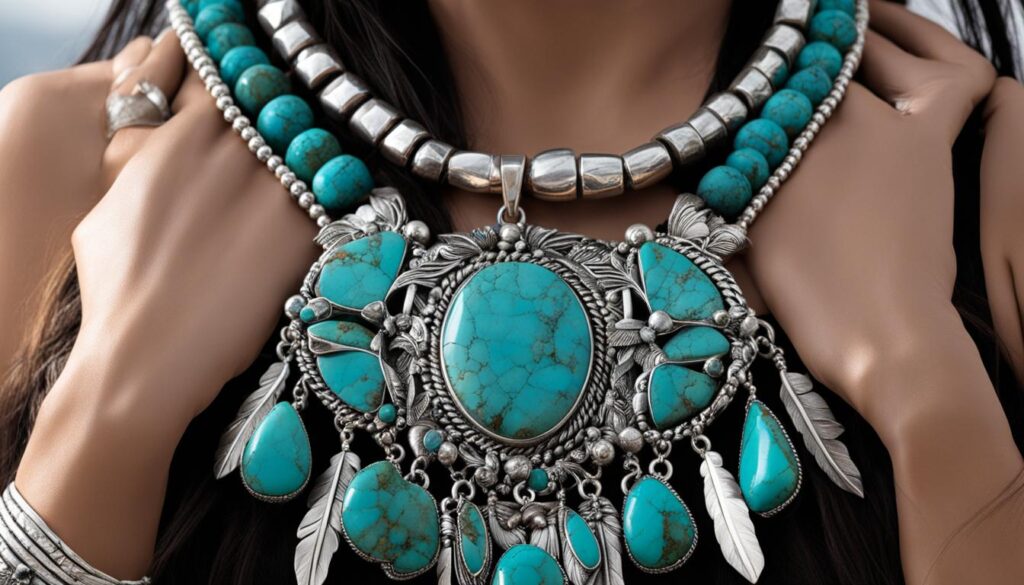 |
 |
The artistry and symbolism of turquoise in Native American jewelry reflect the traditions and beliefs of these tribes. Each piece of turquoise jewelry carries a story and meaning, connecting the wearer to their ancestral heritage and cultural identity.
Furthermore, turquoise is not only limited to traditional styles but also finds expression in contemporary Native American art. Artists like Angie Reano Owen and Na Na Ping incorporate turquoise into their unique creations, blending traditional techniques with modern inspirations. Through their art, these contemporary artists continue to showcase the timeless beauty and significance of turquoise in Native American culture.
Turquoise in Cultural Expressions and Contemporary Artistry
Turquoise holds a special place not only in traditional Native American cultural expressions but also in contemporary art. Artists like Angie Reano Owen and Na Na Ping have skillfully incorporated turquoise into their unique creations, infusing traditional techniques with modern inspirations. Their works showcase the flexibility of turquoise symbolism, allowing artists to express their traditions and beliefs in a contemporary voice.
Angie Reano Owen, a renowned Santo Domingo Pueblo jeweler, draws from her cultural heritage to create stunning pieces of contemporary Native American turquoise jewelry. Her works combine the vibrant colors of turquoise with other materials such as silver, coral, and shell, resulting in breathtaking and innovative designs that pay homage to her roots. Na Na Ping, a Navajo artist, uses turquoise as a key element in her mixed-media art, blending traditional Navajo weaving with modern artistic techniques.
“Turquoise represents an artistic journey that connects me to my ancestors and allows me to express a contemporary vision,” says Angie Reano Owen.
The allure of contemporary Native American turquoise jewelry lies not only in its aesthetic appeal but also in its ability to honor tradition while embracing modern design sensibilities. Contemporary artists often experiment with unconventional shapes, textures, and materials, pushing the boundaries of turquoise symbolism to create innovative and thought-provoking pieces.
The Symbolism of Turquoise in Contemporary Art
Modern interpretations of turquoise symbolism in Native American art showcase the evolving cultural expressions of indigenous peoples. Turquoise continues to be a cherished gemstone that carries profound meaning and serves as a symbol of identity and artistic expression.
Incorporating turquoise into contemporary art allows artists to connect with their cultural heritage while exploring new artistic concepts. The vibrant blue and green hues of turquoise evoke a sense of harmony, balance, and connection to the natural world. It symbolizes healing, protection, and spiritual guidance, conveying the rich cultural and spiritual beliefs of Native American tribes.
“Turquoise is a bridge between the past and the present,” says Na Na Ping. “Through my art, I aim to preserve and celebrate our Native American traditions while embracing contemporary artistic expressions.”
By infusing traditional symbolism with modern aesthetics, contemporary Native American artists keep the legacy of turquoise alive, ensuring its relevance and continued appreciation in today’s cultural landscape.
| Artist | Art Form |
|---|---|
| Angie Reano Owen | Jewelry |
| Na Na Ping | Mixed-media art |
Conclusion
The significance of turquoise in Native American culture is truly profound. This sacred stone holds a special place within the hearts and traditions of Native American tribes throughout the Southwest. Turquoise is not only valued for its aesthetic beauty but also for its spiritual connections and symbolism.
Native Americans believe that turquoise facilitates communication with spirits and acts as a conduit between the physical and spiritual realms. It is also associated with healing and protection, offering strength and well-being to those who wear it. The deep connection between turquoise and the elements of nature further enhances its significance.
The rich symbolism of turquoise is beautifully expressed in Native American jewelry and art. Whether in traditional styles or contemporary interpretations, turquoise serves as a timeless symbol of cultural heritage and identity. The skilled craftsmanship of Navajo and Zuni artisans has made turquoise a central element in their jewelry creations, showcasing the stone’s natural beauty.
In contemporary Native American art, turquoise continues to be a source of inspiration. Artists blend traditional techniques with modern innovations to convey their cultural expressions and beliefs. Through their creations, they ensure that turquoise remains a cherished gemstone that connects and honors the cultural traditions of Native American tribes throughout the Southwest.
FAQ
What is the significance of turquoise in Native American culture?
Turquoise holds deep spiritual significance in Native American culture and is revered as a sacred stone. It is associated with various beliefs and traditions among different tribes throughout the Southwest states.
What is the importance of turquoise to the Navajo people?
Turquoise holds immense importance in Navajo culture and is mentioned in their creation myths. It is used at significant life milestones such as birth, puberty, marriage, and death, as it is associated with healing and protection.
What are the beliefs about turquoise in other Native American tribes?
Turquoise holds deep spiritual connections for other Native American tribes as well. The Zuni people believe that turquoise is a manifestation of the sun’s life-giving power, while the Hopi have a legend that turquoise is created from the excrement of lizards that travel between worlds.
How is turquoise used in Native American ceremonies?
Turquoise is associated with communication with spirits and is believed to bring good fortune and healing. It is used in various ceremonies and rituals to symbolize its significance, such as in a cup filled with a mixture of turquoise and cornmeal by the Zuni.
How is turquoise incorporated into Native American jewelry and art?
Turquoise is a prominent feature in Native American jewelry, particularly in the creations of the Navajo and Zuni tribes. It is used in iconic pieces like the “Naja” and “Squash blossom” necklaces and is also used in contemporary Native American art to express traditions and beliefs.
How does turquoise play a role in contemporary Native American artistry?
Turquoise continues to be used in contemporary Native American art, blending traditional techniques with modern inspirations. Artists like Angie Reano Owen and Na Na Ping have incorporated turquoise into their unique creations, creating a fusion of old and new.
What is the conclusion about the significance of turquoise in Native American culture?
Turquoise holds a profound and multifaceted significance in Native American culture. It is revered as a sacred stone, symbolizing communication with spirits, healing, protection, and connection to the elements. It continues to be a cherished gemstone, embodying the cultural heritage and traditions of Native American tribes throughout the Southwest.


